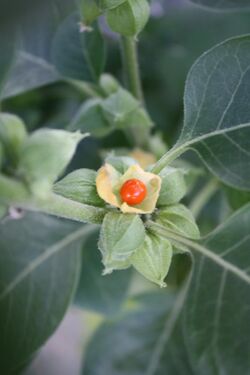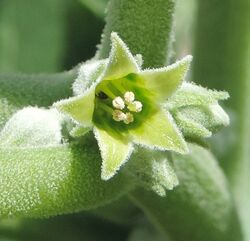Biology:Withania somnifera
| Withania somnifera | |
|---|---|

| |
| Scientific classification | |
| Kingdom: | Plantae |
| Clade: | Tracheophytes |
| Clade: | Angiosperms |
| Clade: | Eudicots |
| Clade: | Asterids |
| Order: | Solanales |
| Family: | Solanaceae |
| Genus: | Withania |
| Species: | W. somnifera
|
| Binomial name | |
| Withania somnifera (L.) Dunal
| |
| Synonyms[1] | |
| |
Withania somnifera, known commonly as ashwagandha or winter cherry,[2][3][4] is an evergreen shrub in the Solanaceae or nightshade family that grows in India, the Middle East, and parts of Africa. Several other species in the genus Withania are morphologically similar.[3]
The plant, particularly its root powder, has been used for centuries in traditional Indian medicine. Although used in herbal medicine and sold as a dietary supplement, there is insufficient scientific evidence that W. somnifera is safe or effective for treating any health condition or disease.[3][4]
Description
This species is a short shrub growing 35–75 cm (14–30 in) tall. Tomentose branches extend radially from a central stem. Leaves are dull green, elliptic, usually up to 10–12 cm (3.9–4.7 in) long. The flowers are small, green and bell-shaped. The ripe fruit is orange-red.[3]
Etymology
The Latin species name somnifera means "sleep-inducing".[5] The name "ashwagandha" is a combination of the Sanskrit words 'ashva', meaning horse, and 'gandha', meaning smell, reflecting that the root has a strong horse-like odor.[3]
Cultivation
W. somnifera is cultivated in many of the drier regions of India . It is also found in Nepal, Sri Lanka, China , and Yemen.[6][7] It prefers dry stony soil with sun to partial shade. It can be propagated from seeds in the early spring or from greenwood cuttings in the later spring.[8]
Diseases and pests
Withania somnifera is prone to several pests and diseases. Leaf spot disease caused by Alternaria alternata is the most prevalent disease, which occurs in a severe form in Punjab, Haryana, and Himachal Pradesh. A decline in the concentration of its secondary metabolites occurs by leaf spot disease.[9] The leaves are also prone to Alternaria dianthicola in India.[10]
A treehopper (Oxyrachis tarandus) feeds on the apical portions of the stem, making them rough and woody in appearance and brown in colour.[11]
The carmine red spider mite (Tetranychus urticae) is the most prevalent pest of the plant in India.[12] In recent years, this plant has been serving as a new reservoir host for an invasive mealybug species Phenacoccus solenopsis.[13]
Phytochemistry
The main phytochemical constituents of W. somnifera are withanolides, a group of triterpene lactones that include withaferin A, alkaloids, steroidal lactones, tropine, and cuscohygrine.[3] Forty withanolides, twelve alkaloids, and various sitoindosides have been isolated from this plant species.[3] Because these withanolides are structurally similar to the ginsenosides of Panax ginseng, W. somnifera is commonly referred to as "Indian ginseng".[3]
Adverse effects
W. somnifera may cause adverse effects if taken alone or together with prescription drugs.[3][4][14] Side effects may include diarrhea, headache, sedation, or nausea, and the product should not be used during pregnancy or breastfeeding.[4][14]
Gallery
References
- ↑ Board of Trustees of the Royal Botanic Gardens, Kew (2023). "Withania somnifera (L.) Dunal". https://powo.science.kew.org/taxon/urn:lsid:ipni.org:names:821709-1.
- ↑ {{citation | mode = cs1 | title = Withania somnifera | work = Germplasm Resources Information Network (GRIN) | url = | publisher = [[Organization:Agricultural Research ServAgricultural Research Service (ARS), United States Department of Agriculture (USDA) | access-date = 2011-10-29 }}
- ↑ 3.0 3.1 3.2 3.3 3.4 3.5 3.6 3.7 3.8 "Ashwagandha". Drugs.com. 2 November 2020. https://www.drugs.com/npp/ashwagandha.html.
- ↑ 4.0 4.1 4.2 4.3 "Ashwagandha". MedlinePlus, US National Library of Medicine. 28 August 2020. https://medlineplus.gov/druginfo/natural/953.html.
- ↑ Stearn, W. T. (1995). Botanical Latin: History, Grammar, Syntax, Terminology and Vocabulary (4th ed.). Timber Press. ISBN 978-0-88192-321-6. https://archive.org/details/botanicallatin00will.
- ↑ Pandit, S.; Chang, K.-W.; Jeon, J.-G. (February 2013). "Effects of Withania somnifera on the growth and virulence properties of Streptococcus mutans and Streptococcus sobrinus at sub-MIC levels". Anaerobe 19: 1–8. doi:10.1016/j.anaerobe.2012.10.007. PMID 23142795.
- ↑ Hugh Scott & Kenneth Mason, Western Arabia and the Red Sea, Naval Intelligence Division: London 1946, p. 597 ISBN:0-7103-1034-X.
- ↑ Deni., Bown (1995). Encyclopedia of herbs & their uses. Montréal: RD Press. ISBN 0888503342. OCLC 32547547.
- ↑ Pati, P. K.; Sharma, M.; Salar, R. K.; Sharma, A.; Gupta, A. P.; Singh, B. (2009). "Studies on leaf spot disease of Withania somnifera and its impact on secondary metabolites". Indian Journal of Microbiology 48 (4): 432–437. doi:10.1007/s12088-008-0053-y. PMID 23100743.
- ↑ Maiti, C. K.; Sen, S.; Paul, A. K.; Acharya, K. (2007-04-01). "First Report of Alternaria dianthicola Causing Leaf Blight on Withania somnifera from India". Plant Disease 91 (4): 467. doi:10.1094/PDIS-91-4-0467B. ISSN 0191-2917. PMID 30781215.
- ↑ Sharma, A; Pati, P.K. (2011). "First report of Withania somnifera (L.) Dunal, as a New Host of Cowbug (Oxyrachis tarandus, Fab.) in plains of Punjab, Northern India.". World Applied Sci. J. 14 (9): 1344–1346.
- ↑ Sharma, A.; Pati, P. K. (2012). "First record of the carmine spider mite, Tetranychus urticae, infesting Withania somnifera in India". Journal of Insect Science 12 (50): 1–4. doi:10.1673/031.012.5001. PMID 22970740.
- ↑ Sharma, A.; Pati, P. K. (2013). "First record of Ashwagandha as a new host to the invasive mealybug (Phenacoccus solenopsis Tinsley) in India". Entomological News 123 (1): 59–62. doi:10.3157/021.123.0114.
- ↑ 14.0 14.1 "Ashwagandha". New York City: Memorial Sloan Kettering Cancer Center. 13 April 2018. https://www.mskcc.org/cancer-care/integrative-medicine/herbs/ashwagandha.
External links
Wikidata ☰ Q852660 entry
 |





